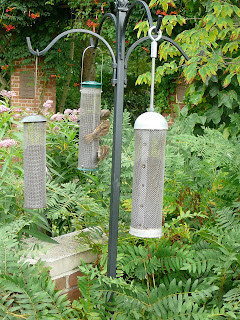Some ideas to consider for creating gardens or recreation spaces that are welcoming, inclusive and accessible to people of all abilities -
ACCESSIBLE PATHWAYS
ACCESSIBLE PATHWAYS
 Wide pathways make it easier for everyone to move through the garden. Make pathways 5 feet wide, if possible, to allow for ease of turning when using a wheelchair or pushing a stroller. At the Accessible Garden at Brookfield Farm, compacted pea gravel was used to create even-surfaced accessible pathways that have lasted well for several years so far.
Wide pathways make it easier for everyone to move through the garden. Make pathways 5 feet wide, if possible, to allow for ease of turning when using a wheelchair or pushing a stroller. At the Accessible Garden at Brookfield Farm, compacted pea gravel was used to create even-surfaced accessible pathways that have lasted well for several years so far.RAISED BEDS
At our accessible garden, we've used easy, ready-to-assemble raised bed kits from a wonderful local family-owned resource, The Farmstead (order online). You can use an old barrel, a pot in a plant stand, or any container of suitable height to create a raised planting area.
In an accessible garden, a variety of raised bed heights allow for various accessibility needs (or adapt the height of a raised bed to suit your particular needs).
Low beds are perfect for little ones. |
Taller beds (30-36 inches high) suit a standing gardener (perhaps someone who uses a walker or someone who cannot bend easily). |
VERTICAL PLANTING
 |
| Simple trellis at The Accessible Garden, Amherst, MA |
A bench in the garden offers a place to sit and rest a while. Consider including accessible picnic tables, too.
SENSORY ASPECTS OF AN ACCESSIBLE GARDEN
COLOR:
SMELL:
Aromatic herbs (lavender, rosemary, thyme, sage, basil) and other fragrant plants help create a "sensory" garden, encouraging visitors to smell, touch, taste and explore.
TOUCH:
Introduce a variety of textures into the garden. Some plants that have tactile qualities are lamb's ears, ornamental grasses, some sedums.
SOUND:
The sound of rustling leaves, birds and water provide interest and relaxation, and also allow for auditory points of orientation within the garden.
- Shade – Some people need to avoid the sun or avoid being in the sun for long periods of time for various medical reasons, and many people appreciate a shady spot to sit in on a hot day -- under a tree, or a vine-covered trellis, or a canopy.
- Swings and/or rocking chairs – swinging or rocking can be a self-modulating activity for some, or relaxing for others.
- If possible, create a private, quiet space within the garden or separate from the garden that people can use if they need a space to regroup or to have a break from all the sensory input of the outdoor environment.
- While in the garden, some people may need ear-protection (earplugs or ear-muffs), some may need eye-protection (sunglasses), and some may need to wear gloves.
*Photographs in this post were taken at the Accessible Garden at Brookfield Farm and at other accessible gardens and accessible recreation spaces that I've visited around the country.


















